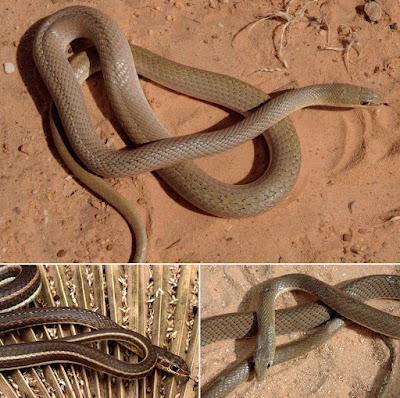 |
| Psammophis afroccidentalis Trape, Böhme & Mediannikov
in Trape, Crochet, Broadley, Sourouille, Mané, et al., 2019.
|
Abstract
Based on molecular, morphological and field data, the status and zoogeography of the taxa of the Psammophis
sibilans group north of 12°S are reviewed. Molecular data including sequences from 20 of the 22 described species known
to occur north of 12°S suggest that P. sibilans distribution is restricted to northeastern Africa, from Egypt to Ethiopia. Populations from West Africa are described as a new species, Psammophis afroccidentalis sp. nov., and those from Chad, Cameroon and
Central African Republic are assigned to P. rukwae which is also distributed from Tanzania to Ethiopia. Molecular data
indicate the occurrence within this complex of three additional cryptic species in the Horn of Africa. Populations previously assigned to P. phillipsi in Central Africa north, south and east of the Congo forest block are assigned to P. mossambicus
and the status of P. occidentalis is discussed. P. phillipsi is restricted to West Africa, with P. irregularis as junior synonym.
Key words. Reptilia, Ophidia; Psammophiinae, Psammophis sibilans, Psammophis afroccidentalis sp. nov., taxonomy,
biogeography, Africa.
 |
| Fig. 4. Psammophis afroccidentalis sp. nov. Plain phase. Sequenced specimen IRD TR.4501. Matmata (Mauritania). |
 |
| Fig. 5. Psammophis afroccidentalis sp. nov. Lineated phase. Dakar (Senegal). |
 |
| Fig. 16. Psammophis afroccidentalis sp. nov. General view of a specimen with a typical dorsal head pattern, ill-defined vertebral chain and lacking pale dorsal stripes. Dielmo, Senegal. |
PSAMMOPHIS AFROCCIDENTALIS Trape,
Böhme & Mediannikov, sp. nov.
West-African Whip Snake,
Psammophis ouest-africain,
Westafrikanische Sandrennnatter
Diagnosis. Distinguishable from other species of the P. sibilans group by the combination of the following characters: 17 scale rows around midbody, 156–185 ventrals, 96–120 subcaudals (rarely less than 100), cloacal divided, 5 infralabials in contact with anterior sublinguals (very rarely 4). Dorsum pale brown, dark brown or greenish-brown, rarely uniform, usually a vertebral chain with the scale of vertebral row paler at base, but this chain often restricted to part of the dorsum, ill-defined and occasionally totally absent; pale dorsolateral stripes on the 4th row of dorsals, but often ill-defined or absent; top of head with a pale median stripe on the snout which forks when reaching the frontal and then borders the frontal, but often ill defined or absent in adults. Genetically diagnosable through possession of unique mitochondrial haplotypes. Psammophis afroccidentalis sp. nov. can be distinguished from P. rukwae by a higher number of subcaudals (P. rukwae 70–100, exceptionnaly up to 105), from P. sibilans by major differences in mitochondrial haplotypes, a pale median stripe that borders the frontal (not bordering the frontal in P. sibilans) and a more uniform dorsal colouration in most specimens, from P. schokari and P. aegyptius by a lower number of subralabials (8 versus 9) and a different head pattern, and from P. sudanensis, P. phillipsi, P. occidentalis, P. mossambicus, P. leopardinus, P. zambiensis and P. subtaeniatus by a higher number of infralabials in contact with the anterior sublinguals (5 versus 4) and by different head and dorsal patterns.
Habitat. Sahel and Sudan savanna in West Africa.
Penetrates in Guinea savanna and relict populations in Sahelo-Saharan wetlands.
Distribution. Mauritania (northernmost record: Tidra
island 19°44’N, 16°24’W), Senegal, Gambia, Guinea
Bissau, Guinea, Mali (northenmost record: Tinjemban
16°44’N, 02°50’W and along the Niger River), Ivory
Coast, Burkina Faso, Ghana, Togo, Benin, Niger (northernmost record: Azzel 17°03’N, 08°03’E), Nigeria and
Chad (Mao). Possibly a relict population in southern Algeria (ZFMK 29365 from 200 km north of Tamanrasset,
a damaged specimen previously assigned to P. rukwae by
Böhme 1986 and to P. sibilans by Hughes 2012).
Jean-François Trape, Pierre-André Crochet, Donald G. Broadley, Patricia Sourouille, Youssouph Mané, Marius Burger, Wolfgang Böhme, Mostafa Saleh, Anna Karan, Benedetto Lanza and Oleg Mediannikov. 2019. On the Psammophis sibilans group
(Serpentes, Lamprophiidae, Psammophiinae) North of 12°S, with the Description of A New Species from West Africa. Bonn zoological Bulletin. 68(1); 61–91. DOI: 10.20363/BZB-2019.68.1.061
